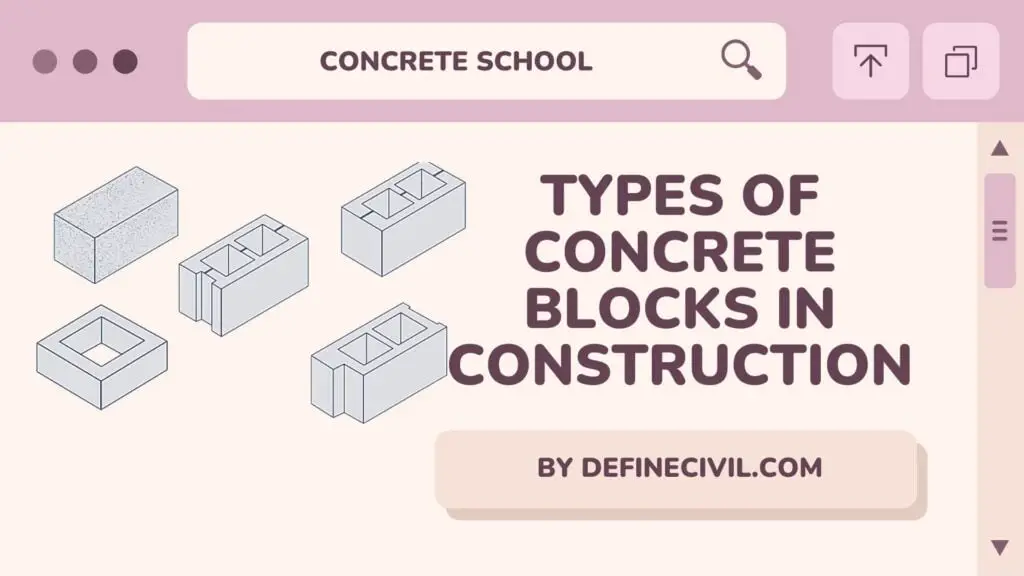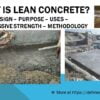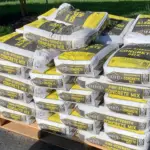When it comes to concrete block types, the most obvious choices are hollow and solid. But the world doesn’t end there. You can choose some specific types of blocks to help you with the project cause and financial benefits.
So, in our today’s read; we’re going to explore different types of concrete blocks. With this guide, you will be at ease in picking the right type for your project.
Concrete Blocks, but why?
A few years back, only red bricks were used in construction of walls. All major buildings were built with red bricks. Until late 1900s, construction experts decided to use AAC Blocks. AAC blocks are precast blocks made with foam concrete. That’s because people become sensitive and aware of damages being caused during processing and manufacturing of red bricks. Further to that, environment protection agencies came forward and stopped the use of earth for making red bricks without permission.
Also Read: Different grades Of Concrete And Their Uses – Concrete Mix Ratio
With such a setback on Brick kiln industry, people started preferring concrete blocks. Casting concrete block is easy and simple. It just needs a mold and the material is readily available. There’s no burning or digging involved causing disruption to the area. It is easy to setup plant and prepare concrete blocks which are more sustainable and durable.
These early blocks were usually made by hand, and the average output was about 10 blocks per person per hour. Today, block manufacturing process is highly automated and can produce 2000 blocks per hour.

What are concrete blocks?
Concrete block is the precast concrete member which is used as building material in construction of walls and called as concrete masonry units (CMU). These concrete blocks are manufactured using cement, aggregate and water with 1:6 as cement-aggregate ratio.
Also Read: Hempcrete Blocks- light weight REPLACEMENT of Concrete –
Size & Strength of concrete blocks
These are manufactured in required shape and size, but the common size of concrete block is (39cm x 19cm x (30cm or 20cm or 10cm)). Concrete blocks are placed one by one and fresh concrete mortar is used to join them to form the wall of desired length and height.
According to ASTM-C-90-91 minimum compressive strength of concrete block is 3N/mm^2.
Also Read: Glass Blocks for wall – Advantages – Disadvantages – Types – Size
Cinder Blocks
You might confuse cinder blocks as concrete blocks. However, both are different in terms of strength and durability.Concrete blocks are made with stone or sand, and are thus heavier. Cinder blocks on the other hand are like lightweight building brick made from small cinders mixed with sand and cement. Due to light weight cinder blocks are also named as breeze blocks. However, they won’t have good tensile strength and can’t withstand great pressure. Concrete blocks are tuff, hard, and durable.
Here’s a detail of how you can make a concrete block or CMU wall.
Types of Concrete Blocks
Concrete blocks are primarily divided into two main types on the basis of shape and size. These includes.
- Solid Concrete Blocks
- Hollow Concrete Blocks
Also Read: Gypcrete Vs Concrete – Difference – Composition – Uses – Pros – Cons
Solid Blocks:
Solid blocks are same as grey brick which is used for the construction of walls that provide safety against deteriorated elements like strong wind, seismic waves, etc.
These blocks are usually large and used in large masonry units that is load bearing in nature.
These are also used in garden walls, retaining walls, foundations, and fire-pits. Solid concrete blocks are heavier than hollow concrete blocks and dense aggregate is used for its manufacturing.
Solid blocks are further divided into following types:
Also Read: Top 8+ skills every Civil Engineer must have– ($$Bonus$$ Tips)
Fly Ash Blocks
Fly ash is a powdery substance that comes from combustion of coal in thermal power plants and is used in the construction of fly ash blocks. These blocks are lighter in weight and come in small sizes. These blocks are used in construction of lightweight structures.
Aerated Autoclave Concrete Block
These are known as AAC Blocks in short form. AAC blocks are manufactured by using very thin and light weight aggregate. These blocks are used in high rise building because they are light weight and reduces the dead load of structure. AAC blocks also offer high degree of sound and temperature insulation.
Paving Blocks
These are square or rectangular in shape and used for paving on road shoulder, walkways, street roads, car parking areas and pathways. These blocks are available in different sizes and colors including sandstone, light brown, anthracite and light grey.
Cellular lightweight Concrete block
These blocks are also light in weight and manufactured using three components like foam, fly ash and cement. These blocks have low normal conductivity, so they are used as fire resistant blocks. These are also used for sound and temperature insulation. These are environmentally friendly and less expensive.
Also Read: How much does a cinder block weigh?
Expanded Clay Aggregate Block
These blocks are manufactures using lightweight aggregates like fly ash and cement. As, these are lightweight, so they reduce the dead weight of building up to 50%. These are waterproof and used as fire resistant blocks, and for sound and temperature insulation.
Hollow Concrete Blocks:
- Hollow concrete blocks come in three different grades that include:
Grade A have minimum density of 1500 kg/m^3.
The density of Grade B is less than 1500 kg/m^3.
Grade C having density greater than 1000 kg/m^3.
- Hollow concrete blocks are load bearing concrete block as well as non-load bearing concrete blocks. Grade A and B are load bearing concrete blocks while Grade C are non-load bearing concrete blocks.
- These blocks are available in sizes like 100x200x400mm, 200x200x400mm, 150x200x400mm, etc.
- These are manufactured using lightweight aggregates with a required design load depending upon nature of member.
- There are void in hollow concrete blocks that are of approximate ¼ of its gross area which are filled using concrete during construction.
Hollow concrete blocks are further divided into following types:
Concrete Stretcher Block
It is used to join corners in masonry wall construction. It is same as hollow block except its shape and size. Size of concrete stretcher block is less than hollow concrete block. These blocks are laid parallel to the face of block.
Concrete Corner Block
These blocks are used at the corners or at the end of windows and doors openings. It is placed in such a way that the one end of its plains is exposed to the exterior, while its other end is used with stretcher block which runs parallel to wall.
Concrete Column Block
These are square blocks with a single hole, which is also referred as double corner block where two ends of corner are visible.
Jamb Block
Its function is same as corner blocks, which is used to connect stretcher masonry wall near windows and doors opening. These are mostly used in double-hung window.
Lintel Blocks
These are also called as channeled or beam blocks, which are mostly known by U-Shape. Deep groove is created because of its u-shape which runs along the length of block and filled up with concreting and reinforcing bars. These blocks are used in construction of lintel beams.
Pillar Block
These are also called as double corner blocks which are used for masonry at the end of windows and doors. These blocks are place parallel to the face of wall.
Partition Block
These are same as pillar blocks except they are taller as compared to width. These are light in weight and easy to handle and used in construction of partition wall.





















A brief readjustment has to be made towards the big lamp posts along my neighborhood street and I’m afraid it will cause major traffic congestions. I’m pretty sure those responsible for the matter must come up with the right actions to sort things out later on. Thanks for making us realize that a hollow concrete block is easier to carry around because of its lightweight.